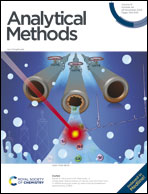Turn-on detection of Al3+ and Zn2+ ions by a NSN donor probe: reversibility, logic gates and DFT calculations†
Abstract
An efficient dual functional naphthalene-derived Schiff base NpSb probe has been synthesised and evaluated for its fluorescence and chromogenic response towards metal ions. The NpSb probe was capable of selectively recognising Al3+ and Zn2+ ions when they were excited at the same wavelength in an aqueous organic solvent system. Almost non-fluorescent NpSb displayed a ‘turn-on’ fluorescence response when treated with Zn2+ (λem = 416 nm) and Al3+ (λem = 469 nm) ions due to the chelation-enhanced fluorescence (CHEF) effect. The limit of detection (LoD) values for Al3+ and Zn2+ have been determined to be 38.0 nM and 43.0 nM, respectively. The binding constants for Al3+ and Zn2+ were found to be 1.18 × 106 M−1 and 3.5 × 105 M−1, respectively. The NpSb also acted as a colorimetric sensor for Al3+ as the colour of the probe's solution turned to pale green from colourless upon Al3+ addition. The binding mechanism between NpSb and Zn2+/Al3+ was supported by the ESI-MS, Job's plot, NMR, and DFT studies. The reversibility experiments were carried out with an F− ion and EDTA with the development of corresponding logic gates. Moreover, NpSb could be applied to detect Al3+ ions in real samples such as tap water, distilled water and soil samples.



 Please wait while we load your content...
Please wait while we load your content...